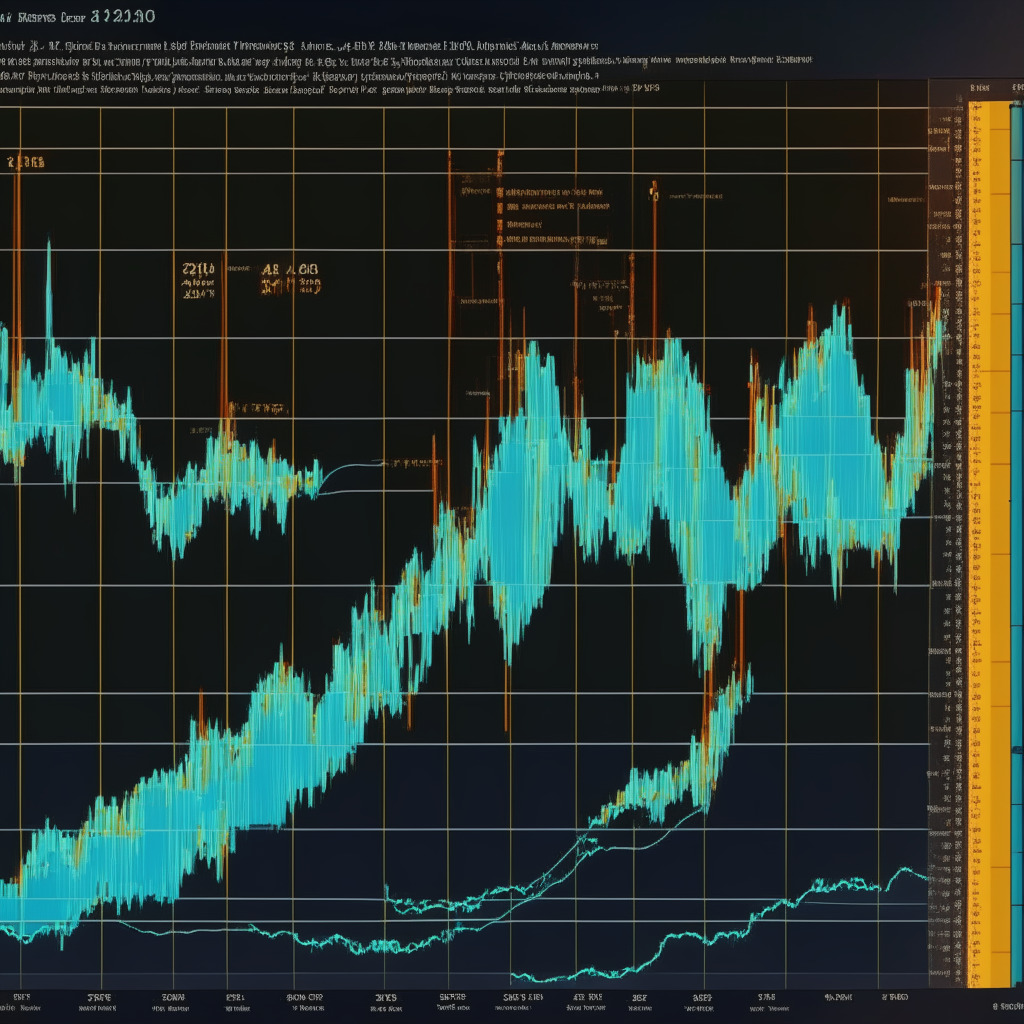Recent favorable employment data from the US Bureau of Labor Statistics sparked a surge in the stock market and a minor rally in the crypto markets. Notable crypto performers include AI, FLOW, SPONGE, ICP, ECOTERRA, CSPR, and SWDTKN. Investors remain optimistic, but caution is advised when investing in volatile digital assets.
Search Results for: Bureau of Labor Statistics
Bitcoin’s Resilience Amid Global Market Uncertainty: A Deep Dive into Prospects and Risks
“Bitcoin, despite recent market turbulence, regained lost ground, reflecting investor optimism. However, the anticipation of the Bureau of Labor Statistics’ release of nonfarm payrolls, along with discussions over Federal Reserve raising interest rates, might influence the crypto behaviour in the near future.”
Bitcoin’s Intraday Volatility and Its Connection to US Inflation Data Release
The U.S. Bureau of Labor Statistics is set to release April’s CPI inflation data, while Bitcoin has exhibited increased intraday volatility around such releases. This trend is tied to the Fed’s monetary policy and may prompt further price fluctuations in the leading cryptocurrency.
Navigating Bitcoin’s Recent Dip: Analyzing Market Reactions and Future Predictions
Bitcoin sees a 4.6% retreat, stirring market interest in buying the dip. Its current circulating supply is nearing its capped total capacity. However, despite a bearish trend, If Bitcoin successfully breaks the $25,400 barrier, significant potential resistance may appear at $25,900 while a bullish crossover could aim towards $26,400 or $27,000.
The Unpredictable Dance Between Bitcoin and Employment Rates: A Dive into Market Turbulence
“The recent U.S. employment statistics have impacted the cryptocurrency market, especially Bitcoin’s price. Despite brief spikes, inherent volatility and external factors like the U.S. employment numbers influence market outcomes. Sustainable growth may require focus on regulatory compliance, economic growth, and finding a balance between stability and volatility for a maturing blockchain future.”
Navigating Bitcoin’s Uncertainty: Halving, ETF Approval and Inflation Impact on BTC Future
“Bitcoin currently stands at $29,400 with two significant events on the horizon – the third Bitcoin halving, scheduled for April 26, 2024, intensifying its scarcity, and an impending decision by the US Securities and Exchange Commission (SEC) on an ETF application, possibly affecting BTC prices.”
Decoding the Complex Dance of Job Growth, Federal Reserve Policies and Bitcoin’s Trajectory
“The U.S. economy added 187,000 jobs in July, slightly lower than predictions. The job growth had a minor influence on Bitcoin’s price, showing some responsiveness of crypto market to macroeconomic indicators. Yet, the crypto market continues to evolve uniquely, potentially serving as a global alternate currency.”
Inflation and Cryptocurrency: Dissecting the Unexpected CPI Impact on Bitcoin
The U.S. CPI (Consumer Price Index) data shows easing inflationary pressures which might affect markets, including the crypto sphere. The discussion around the intersection of economic indicators and cryptocurrency trajectories is ongoing, emphasizing the need for cautious investment and more research.
Cryptocurrency Market Reacts to US Job Gains Miss: Link to Inflation and Fed Policy Decisions
The U.S. added 209,000 jobs in June, below the expected 230,000, causing a slight increase in Bitcoin’s price. Despite the jobs miss ending a 14-month trend of exceeding market anticipations, the overall robust job market places the Federal Reserve in a predicament with the unemployment rate dropping and inflation lingering above target.
FOMC Meeting Impact on Bitcoin: Price Predictions and Breakout Opportunities
Traders and investors await the upcoming FOMC meeting and Fed Rate announcement, which can significantly impact the cryptocurrency market, particularly Bitcoin and Ethereum. Recent analysis introduces an innovative method to examine the Bitcoin network’s hash power using nonce patterns, while the leading cryptocurrency faces resistance at the $26,250 level and finds support around $25,500.
Crypto Prices Rise as Fed Decision Looms: Inflation Gauge Meets Expectations and Affects Market
Cryptocurrency prices experienced an upward movement following the release of key inflation data, with traders anticipating the Federal Reserve maintaining current interest rates. Assets like Bitcoin and Ethereum surged, while the CME Group’s FedWatch Tool revealed a 97% chance of sustained steady rates. The Fed’s decision could impact a wide range of assets, including cryptocurrencies and stocks.
Inflation Data vs Crypto Market: Analyzing Factors Shaping the Future of Cryptocurrency
The US Consumer Price Index (CPI) data for May 2023 showed a 0.1% increase and a 4% rise over the last 12 months. In relation to cryptocurrency market shifts, potential contributors include global events, political situations, technological advancements, and legal issues. Understanding these factors is essential for forecasting future market trends and making informed decisions.
US CPI Inflation Data and Fed’s Decision: Bullish Future for Crypto and Stock Markets?
Wall Street estimates suggest a bullish outlook for crypto and stock markets amid cooling US CPI inflation and the Federal Reserve’s anticipated interest rate decision. This could lead to a rebound for top cryptocurrencies like Bitcoin and Ethereum, following the recent market crash.
Federal Reserve’s Next Move: Impact on Bitcoin and Market Volatility
The jobs report and Federal Reserve’s potential rate hikes, alongside a recently passed debt ceiling deal, play crucial roles in shaping the overall market mood. With the VIX index at a 52-week low, cheaper options prices and macroeconomic events could significantly impact markets.
Impact of Non-Farm Payroll Data on Bitcoin: Analyzing Market Reactions and Future Implications
The recent release of positive Non-Farm Payroll data led to a significant effect on Bitcoin price, exhibiting a downward movement as market sentiment favored a bullish outlook for the US dollar. The market’s response highlights the complexity and unpredictability of the cryptocurrency market, emphasizing the importance of diligent analysis and monitoring of economic indicators when predicting Bitcoin’s price movements.
Impact of Strong Jobs Report and FOMC Meeting on Bitcoin Price: A Tale of Uncertainty and Volatility
The strong jobs report for May 2023 and the upcoming FOMC meeting have created uncertainty in both crypto and traditional markets, potentially impacting Bitcoin’s price. As mixed opinions surround Bitcoin’s future, investors should conduct thorough market research before venturing into cryptocurrencies.
US Job Growth and the Fed’s Impact on Blockchain: Pros, Cons, and Market Conflicts
The U.S. economy’s steady job growth brings mixed implications for the blockchain and cryptocurrency markets, as potential benefits like increased demand for alternative assets may be offset by factors such as rising borrowing costs and potential regulations. Stay informed as the evolving economic landscape impacts crypto markets.
Bitcoin Momentum Amid US Nonfarm Payroll and Mining Expansion: Risks and Rewards
Bitcoin’s price gains momentum as market participants anticipate positive outcomes from the US Non-Farm Payroll data release and its impact on the US dollar. Growing demand in cryptocurrency mining and CFTC’s reassessment of risk management regulations create a bullish momentum for Bitcoin.
Surprising Bitcoin Dip Below $27K: Inflation Data Impact and Market Uncertainties Explained
Bitcoin dipped below $27,000 despite initially positive U.S. inflation data, with over $47 million in BTC long positions liquidated within an hour. Experts suggest the sell-off may be partially driven by correlation with stock market fluctuations, emphasizing the challenge in predicting cryptocurrency market trends.
SUI Price: Fake Breakdown, Bullish Breakout, and the Impact of US CPI Inflation
The SUI price experienced a fake breakdown below $1.17, but reclaimed this level as support after the U.S. CPI inflation came in lower than expected. This bullish breakout offers a potential long-entry opportunity as the crypto market responds to external factors. Investors must remain cautious and conduct diligent research.
Inflation Report Impacts Crypto: How Fed Actions Shape Market Trends & Future Concerns
Cryptocurrency markets experienced an upswing as a key U.S. inflation report showed positive impact on the Federal Reserve’s efforts to combat rising prices. Inflation figures boosted Bitcoin and Ethereum, while the global crypto market cap edged up 0.8%, making monitoring the Fed’s actions essential for crypto enthusiasts in the coming months.
Falling US CPI Inflation Boosts Bitcoin: Navigating Crypto Amid Interest Rate Uncertainty
The annual U.S. CPI inflation rate fell to 4.9% in April, leading to a surge in Bitcoin’s price as traders anticipate the Fed cutting interest rates. Lower inflation could boost the crypto market, but investors must consider risks and fluctuations before investing.
Inflation Rate Slowdown, Bitcoin Reaction, and Federal Reserve Impact on Cryptocurrency
The annual US inflation rate slowed to 4.9% in April, impacting the cryptocurrency market as Bitcoin’s price rose over 1%. This highlights the sensitivity of cryptocurrencies to economic shifts and emphasizes the importance of monitoring inflation rates and economic indicators for market predictions.
CPI Data Release: Impact on Bitcoin Price and US Federal Reserve Decisions
The upcoming CPI data release could influence US Federal Reserve’s decisions on target rate hikes and impact Bitcoin price, potentially creating a bullish scenario for Bitcoin. This development, along with its correlation to tech stocks, will interest crypto enthusiasts and investors.
Exploring the Connection Between US Jobs Report and Bitcoin Price Fluctuations
The recent drop in bitcoin’s price following the jobs report suggests a possible correlation between economic factors and cryptocurrencies. However, skeptics argue that the connection may not be as significant due to their decentralized nature. Interpreting their relationship with real-world economic factors is critical to decipher trends and anticipate developments.
























